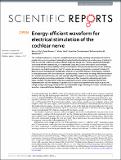| dc.contributor.author | Bowers, Peter | |
| dc.contributor.author | Noel, Victor | |
| dc.contributor.author | Stankovic, Konstantina M. | |
| dc.contributor.author | Yip, Marcus | |
| dc.contributor.author | Chandrakasan, Anantha P | |
| dc.date.accessioned | 2018-05-02T20:12:07Z | |
| dc.date.available | 2018-05-02T20:12:07Z | |
| dc.date.issued | 2017-10 | |
| dc.date.submitted | 2017-01 | |
| dc.identifier.issn | 2045-2322 | |
| dc.identifier.uri | http://hdl.handle.net/1721.1/115199 | |
| dc.description.abstract | The cochlear implant (CI) is the most successful neural prosthesis, restoring the sensation of sound in people with severe-to-profound hearing loss by electrically stimulating the cochlear nerve. Existing CIs have an external, visible unit, and an internal, surgically-placed unit. There are significant challenges associated with the external unit, as it has limited utility and CI users often report a social stigma associated with prosthesis visibility. A fully-implantable CI (FICI) would address these issues. However, the volume constraint imposed on the FICI requires less power consumption compared to today’s CI. Because neural stimulation by CI electrodes accounts for up to 90% of power consumption, reduction in stimulation power will result directly in CI power savings. To determine an energy-efficient waveform for cochlear nerve stimulation, we used a genetic algorithm approach, incorporating a computational model of a single mammalian myelinated cochlear nerve fiber coupled to a stimulator-electrode-tissue interface. The algorithm’s prediction was tested in vivo in human CI subjects. We find that implementation of a non-rectangular biphasic neural stimulation waveform may result in up to 25% charge savings and energy savings within the comfortable range of hearing for CI users. The alternative waveform may enable future development of a FICI. | en_US |
| dc.publisher | Nature Publishing Group | en_US |
| dc.relation.isversionof | http://dx.doi.org/10.1038/S41598-017-13671-Y | en_US |
| dc.rights | Attribution 4.0 International (CC BY 4.0) | en_US |
| dc.rights.uri | https://creativecommons.org/licenses/by/4.0/ | en_US |
| dc.source | Scientific Reports | en_US |
| dc.title | Energy-efficient waveform for electrical stimulation of the cochlear nerve | en_US |
| dc.type | Article | en_US |
| dc.identifier.citation | Yip, Marcus et al. “Energy-Efficient Waveform for Electrical Stimulation of the Cochlear Nerve.” Scientific Reports 7, 1 (October 2017): 13582 © 2017 The Author(s) | en_US |
| dc.contributor.department | Massachusetts Institute of Technology. Department of Electrical Engineering and Computer Science | en_US |
| dc.contributor.mitauthor | Yip, Marcus | |
| dc.contributor.mitauthor | Chandrakasan, Anantha P | |
| dc.relation.journal | Scientific Reports | en_US |
| dc.eprint.version | Final published version | en_US |
| dc.type.uri | http://purl.org/eprint/type/JournalArticle | en_US |
| eprint.status | http://purl.org/eprint/status/PeerReviewed | en_US |
| dc.date.updated | 2018-04-27T16:40:44Z | |
| dspace.orderedauthors | Yip, Marcus; Bowers, Peter; Noel, Victor; Chandrakasan, Anantha; Stankovic, Konstantina M. | en_US |
| dspace.embargo.terms | N | en_US |
| dc.identifier.orcid | https://orcid.org/0000-0002-5977-2748 | |
| mit.license | PUBLISHER_CC | en_US |
